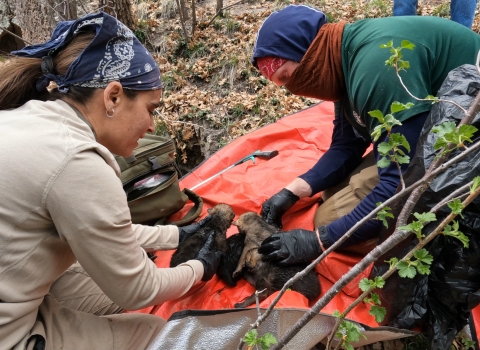President Donald Trump has proposed a budget of $1.3 billion in Fiscal Year 2020 to fund the U.S. Fish and Wildlife Service’s principal resource management and conservation programs. The budget includes an additional $1.5 billion in permanent funding that is administered to states through grants that support state wildlife and sport fish conservation, recreational boating and other related programs. The Service’s Budget in Brief is available online at https://www.doi.gov/budget/appropriations/2020. The full Service budget justification is online at https://www.fws.gov/budget/2020/FY2020-FWS-Budget-Justification.pdf.
The President’s Budget prioritizes investments to increase access to outdoor recreational opportunities, improve permitting processes, modernize infrastructure and recover species listed under the Endangered Species Act.
“Serving the American people is our highest priority and this budget will help us strengthen our commitment to them,” said the Service’s Principal Deputy Director Margaret Everson. “From improving the experience for our refuge visitors to recovering the nation’s most imperiled species to making our regulations as transparent and streamlined as possible, we are focused on building the modern, public focused organization that America expects and deserves.”
The FY 2020 budget includes the President’s continued focus on the following priorities:
Conserving our Lands and Waters
Operation and maintenance of the National Wildlife Refuge System (NWRS), the world’s premier network of lands managed explicitly for wildlife conservation, is supported at $509.5 million. Of this, $239.4 million is for wildlife and habitat management through activities such as forestry and combating invasive species invasive species
An invasive species is any plant or animal that has spread or been introduced into a new area where they are, or could, cause harm to the environment, economy, or human, animal, or plant health. Their unwelcome presence can destroy ecosystems and cost millions of dollars.
Learn more about invasive species .
The President requests $240 million to conserve, protect and enhance endangered, threatened and at-risk wildlife and their habitats. The budget prioritizes $107.5 million in funding for planning and consultation and $95 million for species recovery activities. The request also includes $26.4 million for conservation and restoration activities that can help keep at-risk species off the threatened and endangered species lists.
The budget proposes $73.4 million for aquatic habitat and species conservation, including $16.1 million to block, control and eradicate aquatic invasive species such as Asian carp and non-native mussels, and $14 million for fish passage fish passage
Fish passage is the ability of fish or other aquatic species to move freely throughout their life to find food, reproduce, and complete their natural migration cycles. Millions of barriers to fish passage across the country are fragmenting habitat and leading to species declines. The U.S. Fish and Wildlife Service's National Fish Passage Program is working to reconnect watersheds to benefit both wildlife and people.
Learn more about fish passage improvements that enable fish to access additional habitat, which also bolsters fishing opportunities for the American public.
To further habitat conservation priorities, the President requests $54.4 million to support voluntary conservation on private lands through the Partners for Fish and Wildlife Program, and $13.4 million to promote coastal habitat conservation on public and private lands.
The budget also requests $16.6 million for technical and financial assistance to international partners for innovative projects that address wildlife poaching and trafficking and support international conservation efforts.
Encapsulated in the Service’s mission is the mandate to work with others to achieve shared wildlife conservation goals. To that end, the Service promotes collaborative conservation through a range of funding sources for diverse state, tribal, nongovernmental organization and private partners. This year, the President is requesting $6 million for the Multinational Species Conservation Fund to leverage support from partners to protect elephants, rhinos, tigers, great apes and marine turtles; $40 million for the North American Wetlands Conservation Fund that supports cost-shared partnership projects for wetlands and waterfowl conservation; $3.9 million for the Neotropical Migratory Bird Conservation Fund to provide matching grants for neotropical migratory bird conservation projects throughout the Western Hemisphere; and $31.3 million for State and Tribal Wildlife Grants for conservation of non-game species.
Expanding Outdoor Recreation and Access
The President is requesting $80.9 million for NWRS visitor services and $43.2 million for visitor safety to ensure safe, easy and diverse access to public lands for wildlife-dependent recreation.
Migratory bird hunters generate $2.3 billion in economic activity each year, much of it in rural America. The FY 2020 budget includes $49.5 million for migratory bird management to support population monitoring, cooperation with states on migratory bird management, and environmental reviews required for development projects. The budget also includes $13.1 million for the North American Waterfowl Management Plan to support joint ventures, multifaceted regional partnerships that conserve habitat for migratory birds across North America.
The budget request for Fish and Aquatic Conservation is $155.6 million, which will support access to recreational fishing and fisheries conservation.
Modernizing our Organization and Infrastructure for the Next 100 Years
Funding for the NWRS includes $146 million for refuge facility and equipment maintenance. Addressing health and human safety deficiencies at existing facilities is the highest priority for maintenance funding.
Funding for Fish and Aquatic Conservation includes $82.2 million for the operation and maintenance of the National Fish Hatchery System. These resources will help modernize hatchery infrastructure and facilities to reduce operating costs and improve research and fish production capabilities.
The 2020 budget proposes $9.9 million for Service land acquisition. The budget reflects the Administration’s priority to support management of existing lands and resources over acquisition of new federal lands.
In addition to funding available through the Public Lands Infrastructure Fund, the FY 2020 budget for construction is $15.7 million, of which $9.1 million is for line-item construction projects.
As part of the Department’s reorganization effort, the Service’s budget includes $5.7 million to support unified regions, relocate resources closer to customers, and implement shared service solutions to better deliver operational services across the Department.
Protecting our People and the Border
Included in the budget request for the NWRS is $43.2 million for refuge law enforcement efforts. This money ensures the safety of the more than 55 million annual visitors across the refuge system, prevents poaching and other illegal activities that may harm wildlife and their habitats, and assists U.S. Customs and Border Protection officers in their critically important efforts to secure our borders.
Wildlife crime is a multi-billion-dollar global business that fuels international instability and has been linked to other illicit activities such as human, arms and drug trafficking. The President’s budget asks for $77.2 million for law enforcement activities investigating wildlife crimes and enforcing wildlife laws. The budget supports continuing cooperation with other nations to protect elephants, rhinos, pangolins and other species by stopping illicit trade, ensuring sustainable legal trade, reducing demand for illegal products, and providing technical assistance and grants to other nations to develop local enforcement capabilities.
Generating revenue and Utilizing our Natural Resources
The President’s FY 2020 budget proposal supports his commitment to create jobs, provide outdoor recreation through hunting and fishing, facilitate energy development, and support law enforcement needs.
The Department of the Interior oversees one-fifth of the nation’s land and the entire Outer-Continental Shelf. The Department is charged with overseeing energy development on federal lands and waters, grazing allotments and timber sales, water conservation and delivery, upholding tribal trust responsibilities, conservation of wildlife and habitat, and maintaining access for recreation throughout public lands, among other priorities. With this budget, the Service is able to effectively fulfill its mission and address conservation priorities.


